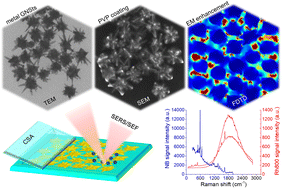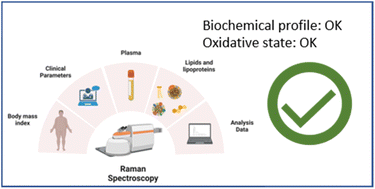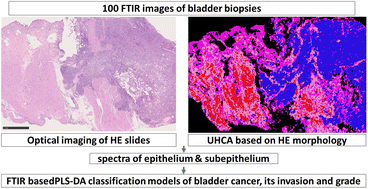Themed collection SPEC 2022: International Conference on Clinical Spectroscopy

SPEC 2022: International Conference on Clinical Spectroscopy
Aidan D. Meade, Fiona M. Lyng and Hugh J. Byrne introduce the Analyst themed issue on SPEC 2022: International Conference on Clinical Spectroscopy.

Analyst, 2023,148, 6143-6145
https://doi.org/10.1039/D3AN90074F
Fast cancer imaging in pancreatic biopsies using infrared imaging
Pancreatic cancer, particularly Pancreatic ductal adenocarcinoma, remains a highly lethal form of cancer with limited early diagnosis and treatment options.

Analyst, 2024,149, 1799-1806
https://doi.org/10.1039/D3AN01555F
Diffuse reflectance spectroscopy for colorectal cancer surgical guidance: towards real-time tissue characterization and new biomarkers
Our study assessed the most important light-based markers for surgical and laparoscopic delineation of colorectal cancer margins. Real-time and accurate tissue identification can improve surgical outcomes and obviate the need for multiple biopsies.

Analyst, 2024,149, 88-99
https://doi.org/10.1039/D3AN00261F
Effect of pre-analytical variables on Raman and FTIR spectral content of lymphocytes
This work describes how pre-analytical variables such as sample handling, storage and processing can influence the biochemical signature of lymphocytes.

Analyst, 2023,148, 5422-5434
https://doi.org/10.1039/D3AN00686G
Dimensionality reduction for deep learning in infrared microscopy: a comparative computational survey
We compare dimensionality reduction approaches and their effect on identifying cancer in infrared microscopic images. Neural networks trained on reduced spectra perform surprisingly well, indicating the importance of spatial information.

Analyst, 2023,148, 5022-5032
https://doi.org/10.1039/D3AN00166K
Fabrication and characterization of multi-biomarker optimized tissue-mimicking phantoms for multi-modal optical spectroscopy
This study developed gelatin-based phantoms optimized across a broad range of optical properties. These well-characterized, multi-biomarker phantoms have the potential to expedite the development of multimodal optical spectroscopy devices for clinical translation.

Analyst, 2023,148, 4768-4776
https://doi.org/10.1039/D3AN00680H
Towards non-invasive monitoring of non-melanoma skin cancer using spatially offset Raman spectroscopy
Spatially offset Raman spectroscopy revealed a correlation of protein and lipid content with non-melanoma skin cancer. Multiple factor analysis on the same data demonstrated clustering based on pathology rather than interpatient variability.

Analyst, 2023,148, 4386-4395
https://doi.org/10.1039/D3AN00684K
Multivariate curve Resolution-Alternating least squares coupled with Raman microspectroscopy: new insights into the kinetic response of primary oral squamous carcinoma cells to cisplatin
Raman MicroSpectroscopy (RMS) is a powerful label-free tool to probe the effects of drugs at a cellular/subcellular level.

Analyst, 2023,148, 4365-4372
https://doi.org/10.1039/D3AN01182H
High wavenumber Raman spectroscopy for intraoperative assessment of breast tumour margins
Spectra taken using a HWN Raman probe from bisected mastectomy specimens are capable of identifying tumour versus normal tissue through the difference in water, protein and lipid content.

Analyst, 2023,148, 4373-4385
https://doi.org/10.1039/D3AN00574G
Tissue discrimination in head and neck cancer using image fusion of IR and optical microscopy
Fusion of FTIR with H&E images reveals the contributions of collagen, DNA and cytokeratin in metastatic/lymphoid tissue at high spatial resolution.

Analyst, 2023,148, 4189-4194
https://doi.org/10.1039/D3AN00692A
Classification of formalin-fixed bladder cancer cells with laser tweezer Raman spectroscopy
Raman optical tweezers identifies the invasive bladder cancer cell line, strengthening the argument for a spectroscopic based urine cytology test.

Analyst, 2023,148, 4099-4108
https://doi.org/10.1039/D3AN00119A
Intraoperative assessment of resection margins by Raman spectroscopy to guide oral cancer surgery
Raman spectroscopic technology for quick and accurate assessment of tumor resection margins.

Analyst, 2023,148, 4116-4126
https://doi.org/10.1039/D3AN00650F
Self-assembled PVP-gold nanostar films as plasmonic substrates for surface-enhanced spectroscopies: influence of the polymeric coating on the enhancement efficiency
High-density, compact self-assembled gold nanostar films were prepared by convective self-assembly. An interplay between the enhanced Raman scattering and emission of fluorophores points toward their SERS/SEF dual detection capability.

Analyst, 2023,148, 3992-4001
https://doi.org/10.1039/D3AN00682D
Feasibility of Raman spectroscopic identification of gall bladder cancer using extracellular vesicles extracted from bile
Extracellular vesicles (EVs) extracted from human bile could be versatile biomarkers for the identification of gall bladder cancer.

Analyst, 2023,148, 4156-4165
https://doi.org/10.1039/D3AN00806A
Identification of bacteria in mixed infection from urinary tract of patient's samples using Raman analysis of dried droplets
Raman spectroscopy approach based on dried droplets, for mixed UTI bacterial pathogens identification.

Analyst, 2023,148, 3806-3816
https://doi.org/10.1039/D3AN00679D
Weakly supervised anomaly detection coupled with Fourier transform infrared (FT-IR) spectroscopy for the identification of non-normal tissue
A novel weakly supervised anomaly detection machine learning method is used to identify non-normal tissue subgroups, interferents, and other tissue components in IR Micro-spectroscopy liver tissue data when trained on a single control group of data.

Analyst, 2023,148, 3817-3826
https://doi.org/10.1039/D3AN00618B
Vibrational and chiroptical analysis of blood plasma for hepatocellular carcinoma diagnostics
Using a combination of vibrational and chiroptical spectroscopy together with principal component analysis and a random forest algorithm, we have successfully distinguished patients with hepatocellular carcinoma from patients with cirrhosis.

Analyst, 2023,148, 2793-2800
https://doi.org/10.1039/D3AN00164D
In vivo Raman spectroscopy in the diagnostics of colon cancer
In vivo Raman spectroscopy coupled with machine learning methods was used for tissue diagnostics of precancerous and cancerous lesions of the colon and rectum.

Analyst, 2023,148, 2518-2526
https://doi.org/10.1039/D3AN00103B
Metric-based analysis of FTIR data to discriminate tissue types in oral cancer
Comparison of (a) H&E image of oral squamous cell carcinoma with (b) ratio of absorbance at 1252 cm−1/1285 cm−1 and (c) pseudo-coloured labelled image of seven types of tissue found in oral tissue.

Analyst, 2023,148, 1948-1953
https://doi.org/10.1039/D3AN00258F
A clinical Raman spectroscopy imaging system and safety requirements for in situ intraoperative tissue characterization
A clinical prototype Raman macroscopic imaging system for machine-learning-based molecular tissue margin characterization over a large field of view.

Analyst, 2023,148, 1991-2001
https://doi.org/10.1039/D2AN01946A
Probing the interaction of ex situ biofilms with plasmonic metal nanoparticles using surface-enhanced Raman spectroscopy
Ex situ biofilm samples were used to study the interactions between SERS-enhancing Ag and Au particles and biofilm components without the complexity associated with highly structured in situ biofilms.

Analyst, 2023,148, 2002-2011
https://doi.org/10.1039/D3AN00301A
High-throughput Raman spectroscopy allows ex vivo characterization of murine small intestinal intra-epithelial lymphocytes (IEL)
Intestinal inflammation-driving T cells within the epithelial layer of the small intestine can be identified and further characterized by Raman spectroscopy ex vivo.

Analyst, 2023,148, 1978-1990
https://doi.org/10.1039/D3AN00074E
Determination of the quality of lipoproteins by Raman spectroscopy in obese and healthy subjects
Raman spectroscopy (RS) detects the quality of lipoproteins (LPs) extracted from obese patients and healthy subjects. RS simultaneously identified clear differences in the LPs composition and in the oxidation state between the two groups.

Analyst, 2023,148, 2012-2020
https://doi.org/10.1039/D3AN00051F
Recurrent neural networks for time domain modelling of FTIR spectra: application to brain tumour detection
A recurrent neural network trained on time domain data can accurately identify brain tumours from serum spectral data.

Analyst, 2023,148, 1770-1776
https://doi.org/10.1039/D2AN02041F
Evaluation of grade and invasiveness of bladder urothelial carcinoma using infrared imaging and machine learning
We combined infrared (IR) microscopy of bladder sections with machine learning (partial least squares-discriminant analysis) to provide an automated methodology for the prediction of the presence of cancer, invasiveness and grade.

Analyst, 2023,148, 278-285
https://doi.org/10.1039/D2AN01583H
About this collection
This collection of articles highlights work from the 12th conference in the SPEC series, held in Dublin, Ireland, 19-23 June 2022. Guest Edited by Aidan D. Meade, Fiona M. Lyng and Hugh J. Byrne. New articles will be added to this collection as they are published.